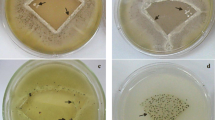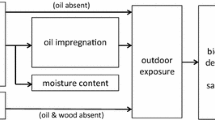Abstract
Chaetomium globosum, the most common species within this genus, produces chaetoglobosins A and C when cultured on building material. Relatively low levels of these compounds have been shown to be lethal to various tissue culture cell lines. This study had two major objectives: (1) to determine the frequency at which Chaetomium species are isolated in water-damaged buildings and (2) to examine the production of chaetoglobosins A and C in isolates of C. globosum obtained from different buildings. Out of 794 water-damaged buildings, Chaetomium species were isolated in 49% of these structures. C. globosum ATCC 16021 was grown on four different media: oatmeal agar (OA), potato dextrose agar (PDA), corn meal agar (CMA), and malt extract agar (MEA). After 4 weeks, fungal growth was evaluated based on colony diameter and the quantity of spores produced on agar plates. In addition, production of chaetoglobosin A and C was monitored using high performance liquid chromatography. Colony diameter, spore production, and mycotoxin production by C. globosum were the highest on OA. Out of 30 C. globosum isolates cultured on OA for 4 weeks, 16 produced detectable amounts of chaetoglobosin A and every isolate produced chaetoglobosin C.
Similar content being viewed by others
References
Brightman HS, Moss N. Sick building syndrome studies and the compilation of normative and comparative values. In: Spengler JD, Samet JM, McCarthy JF, editors. Indoor air quality handbook. Washington D.C.: McGraw-Hill; 2000. p. 3.1–3.32.
Li D, Yang CS. Fungal contamination as a major contributor to sick building syndrome. In: Straus DC, editor. Sick building syndrome. San Diego: Elsevier; 2004. p. 31–112.
Cooley JD, Wong WC, Jumper CA, Straus DC. Fungi and the indoor environment: Their impact on human health. In: Straus DC, editor. Sick building syndrome. San Diego: Elsevier Academic Press; 2004. p. 3–30.
Centers for Disease Control and Prevention. Mold prevention strategies and possible health effects in the aftermath of hurricanes and major floods. MMWR 2006;55(No. RR-8):1–27.
Burge HA, Otten JA. Chapter 19. Fungi. In: Macher J, editor. Bioaerosols: assessment and control. Cincinnati, OH: ACGIH Worldwide; 1999.
Burge HA. The fungi. In: Spengler JD, Samet JM, McCarthy JF, editors. Indoor air quality handbook. Washington, D.C.: McGraw-Hill; 2000. p. 45.1–45.33.
Sorenson WG. Fungal spores: hazardous to health? Environ Health Perspect 1999;107(Suppl 3):469–72.
Jarvis BB, Miller JD. Mycotoxins as harmful indoor air contaminants. Appl Environ Biotechnol 2005;66:367–72.
Nielsen KF, Gravesen S, Nielsen PA, Andersen B, Thrane U, Frisvad JC. Production of mycotoxins on artificially and naturally infested building materials. Mycopathologia 1999;145:43–56.
Nielsen KF. Mycotoxin production by indoor molds. Fungal Genet Biol 2003;39:103–17.
Sutton DA, Fothergill A, Rinaldi MG. Guide to clinically significant fungi. Baltimore: Williams and Wilkins; 1998.
Andersen B, Nissen AT. Evaluation of media for detection of Stachybotrys and Chaetomium species associated with water-damaged buildings. Int Biodeterior Biodegradation 2000;46:111–6.
Alberts B, Johnson A, Lewis J, Raff M, Roberts K, Walter P. Chapter 16. The cytoskeleton. In: Molecular biology of the cell. 4th ed. New York: Garland Science; 2002.
Umeda M, Ohtsubo K, Saito M, Sekita S, Yoshihira K, Natori S, et al. Cytotoxicity of new cytochalasans from Chaetomium globosum. Experientia 1975;31:435–8.
Umeda M. Cytotoxicity of mycotoxins. In: Rodricks JV, Hesseltine CW, Mehlman MA, editors. Mycotoxins in human and animal health. Park Forest South, Illinois: Pathotox Publishers; 1977.
Ohtsubo K, Saito M, Sekita S, Yoshihira K, Natori S. Acute toxic effects of chaetoglobosin A, a new cytochalasan compound produced by Chaetomium globosum, on mice and rats. Jap J Exp Med 1978;48(2):105–10.
Power DA, Zimbro MJ. Difco & BBL manual of microbiological culture media. 1st ed. BD Diagnostic Systems; 2003.
Atlas RM. Handbook of microbiological media. 3rd ed. New York: CRC Press; 2004.
Watanabe T. Pictorial atlas of soil and seed fungi. Morphologies of cultured fungi and key to species. 2nd ed. Boca Raton, FL: CRC Press; 2002.
Shelton BG, Kirkland KH, Flanders WD, Morris GK. Profiles of airborne fungi in buildings and outdoor environments in the United States. Appl Environ Microbiol 2002;68(4):1743–53.
Kozak PP, Gallup J, Cummins LH, Gillman SA. Factors of importance in determining the prevalence of indoor molds. Ann Allergy 1979;43:88–94.
Gravesen S, Larsen L, Gyntelberg F, Skov P. Demonstration of microorganisms and dust in schools and offices. Allergy 1986;41:520–5.
Vesper SJ, McKinstry C, Yang C, Haughland RA, Kercsmar CM, Yike I, et al. Specific molds associated with asthma in water-damaged homes. J Occup Environ Med 2006;48(8):852–8.
Gravesen S. Identification and prevalence of culturable mesophilic microfungi in house dust from 100 Danish homes. Allergy 1978;33:268–72.
Brewer D, Taylor A. The production of toxic metabolites by Chaetomium spp. isolated from soils of permanent pasture. Can J Microbiol 1978;24:1082–6.
Sekita S, Yoshihira K, Natori S, Udagawa S, Murol T, Sugiyama Y, et al. Mycotoxin production by Chaetomium spp. and related fungi. Can J Microbiol 1981;27:766–72.
Udagawa S, Murol T, Kurata H, Sekita S, Yoshihira K, Natori S, et al. The production of chaetoglobosins, sterigmatocystin, O-methylsterigmatocystin, and chaetocin by Chaetomium spp. and related fungi. Can J Microbiol 1979;25:170–7.
Jarvis BB. Analysis for mycotoxins: the chemist’s perspective. Arch Environ Health 2003;58(8):479–83.
Gregory L, Pestka JJ, Dearborn DG, Rand TG. Localization of satratoxin-G in Stachybotrys chartarum spores and spore-impacted mouse lung using immunocytochemistry. Toxicol Pathol 2004;32:26–34.
Calvo AM, Wilson RA, Bok JW, Keller NP. Relationship between secondary metabolism and fungal development. Microbiol Mol Biol Rev 2002;66(3):447–59.
Brasel TL, Douglas DR, Wilson SC, Straus DC. Detection of airborne Stachybotrys chartarum macrocyclic trichothecene mycotoxins on particles smaller than conidia. Appl Environ Microbiol 2005;71(1):114–122.
Brasel TL, Martin JD, Carriker CG, Wilson SC, Straus DC. Detection of airborne Stachybotrys chartarum macrocyclic trichothecene mycotoxins in the indoor environment. Appl Environ Microbiol 2005;71(11):7376–7388.
Charpin-Kadouch C, Maurel G, Felipo R, Queralt J, Ramadour M, Dumon H, et al. Mycotoxin identification in moldy dwellings. J Appl Toxicol 2006;26:475–9.
Brasel TL, Campbell AW, Demers RE, Ferguson BS, Fink J, Vojdani A, et al. Detection of trichothecene mycotoxins in sera from individuals exposed to Stachybotrys chartarum in indoor environments. Arch Environ Health 2004;59(6):317–23.
Yike I, Distler AM, Ziady AG, Dearborn DG. Mycotoxin adducts on human serum albumin: Biomarkers of exposure to Stachybotrys chartarum. Environ Health Perspect 2006;114:1221–6.
Acknowledgments
Funding for this project was provided by Grant No. T42 CCT610417-11 from the National Institute for Occupational and Environmental Health (NIOSH)/Centers for Disease Control and Prevention (CDC) to the Southwest Center for Occupational and Environmental Health (SWCOEH), a NIOSH Education and Research Center. Isolates of Chaetomium species were kindly provided by Janice Jones at Aerotech Laboratories (Phoenix, AZ), Dr Weiqun Chen at P&K Microbiology Services (Cherry Hill, NJ) and Dr Larysa Andriychuk at the Center for Indoor Air Research (Lubbock, TX). The authors also thank Assured Indoor Air Quality (Dallas, TX) for access to their database and Dr Stephen C. Wilson for critical review of this manuscript. In addition, much gratitude is given to Dr Birgitte Andersen at the Center for Microbial Biotechnology at the Technical University of Denmark (Lyngby, Denmark) for analyzing our methanol extracts and confirming the presence of chaetoglobosins A and C.
Author information
Authors and Affiliations
Corresponding author
Rights and permissions
About this article
Cite this article
Fogle, M.R., Douglas, D.R., Jumper, C.A. et al. Growth and mycotoxin production by Chaetomium globosum . Mycopathologia 164, 49–56 (2007). https://doi.org/10.1007/s11046-007-9023-x
Received:
Accepted:
Published:
Issue Date:
DOI: https://doi.org/10.1007/s11046-007-9023-x




